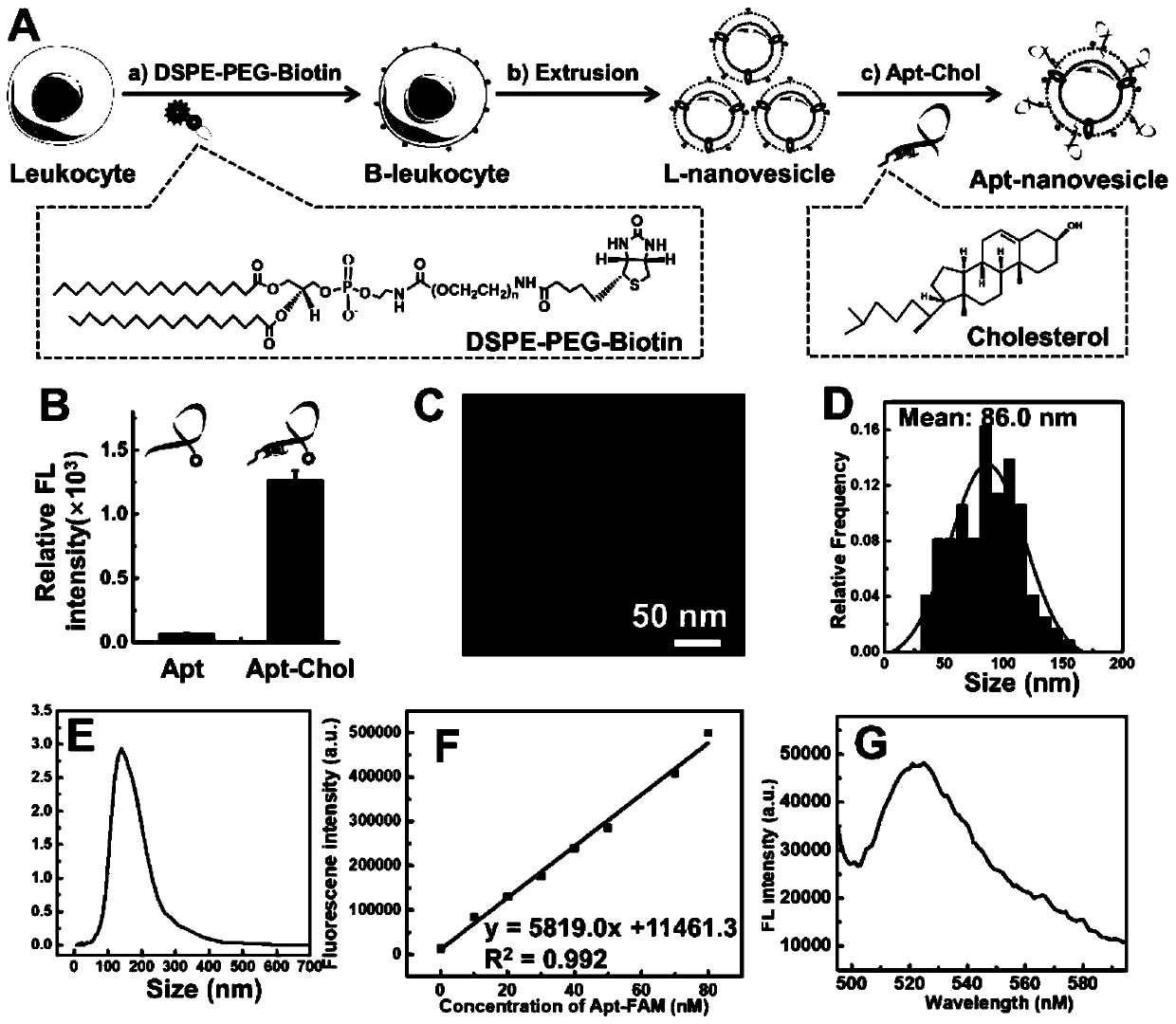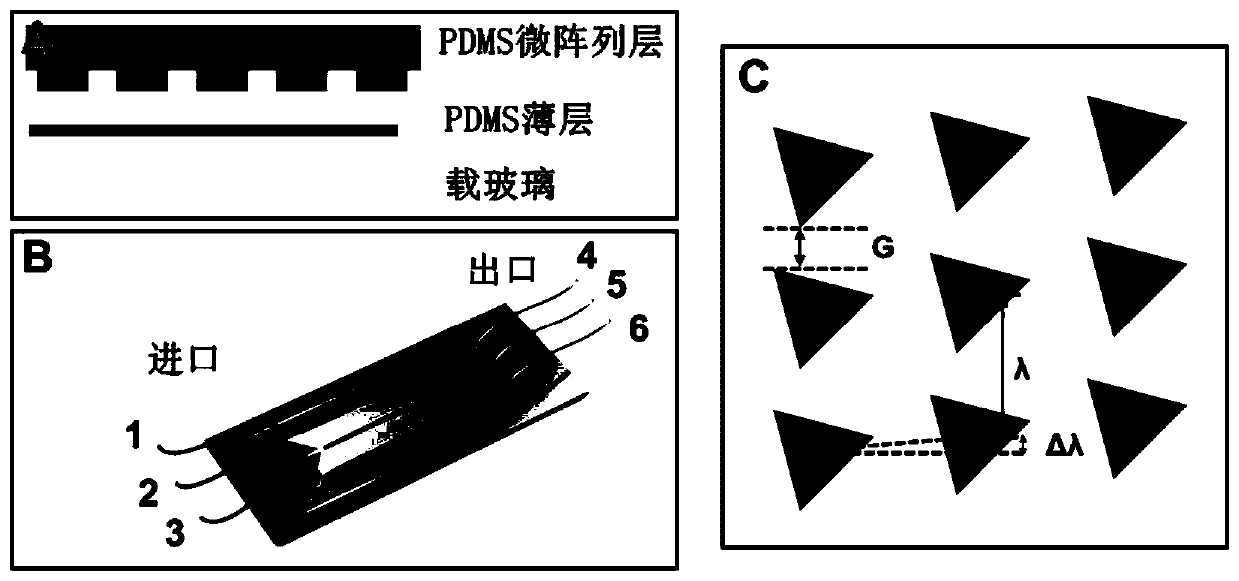Flow identification nano vesicle used for cell capture, and preparation method and applications thereof
A nanovesicle, cell technology, applied in cell dissociation methods, biochemical equipment and methods, bioreactors/fermenters for specific purposes, etc., can solve problems such as few multivalent effects, and reduce non-specific adsorption , the effect of good monodispersity and low polydispersity index
- Summary
- Abstract
- Description
- Claims
- Application Information
AI Technical Summary
Problems solved by technology
Method used
Image
Examples
preparation Embodiment 1
[0047] Preparation Example 1 Preparation of flow recognition nanovesicles for cell capture
[0048] Such as figure 1 As shown in A, the leukocyte membrane-derived flow-recognition nanovesicles for cell capture were prepared by a top-down method: 1) Mouse macrophage J774A.1 was selected as a model leukocyte, and J774A. 1 Cells were routinely cultured with medium containing DSPE-PEG-biotin (60 μM) for 3 h (attached figure 1 A(a)); 2) Collect the above-mentioned biotinylated J774A.1 cells, use a homogenizer to break the cells to form a homogenate, and centrifuge through a sucrose density gradient (the mass concentration gradient is 30%, 40%, 50% , 28000rpm, 2h) to separate and purify the cell membrane fragments; 3) collect the cell membrane fragments, and use a nano-extruder to extrude the cell membrane fragments into surface biotinized nanovesicles with a particle size of about 100nm (attached figure 1 A(b)); 4) In order to endow biomimetic nanovesicles with tumor cell recogni...
preparation Embodiment 2
[0049] Preparation Example 2 Preparation of Flow Recognition Nanovesicle Modified Microfluidic Chip for Cell Capture
[0050] See attached figure 2 A-C, to make a microfluidic chip, from top to bottom, the PDMS microarray layer, PDMS thin layer, and glass carrier are sequentially bonded with oxygen plasma to form a complete chip. There are three sample inlets (1), (2), (3) on both sides of the chip (1 and 3 are for buffer solution injection, 2 is for whole blood sample injection) and three sample outlets (4), (5) , (6), between the sample inlet and the sample outlet is a triangular microarray, wherein the microarray arrangement adopts the DLD design principle, and the chip arranged by the microcolumn is called DLD-Chip for short, as shown in the attached figure 1 Shown in B.
[0051] In this embodiment, the chip size is designed to be 1 cm wide and 4.5 cm long.
[0052] In this embodiment, the vertical distance G between the pillars is set to 32 μm, the distance λ between ...
experiment Embodiment 1
[0054] Experimental example 1 Selective recognition of flow-recognized nanovesicles for cell capture and EpCAM-positive SW480 tumor cells
[0055] In order to investigate the ability and specificity of the above-mentioned flow recognition nanovesicles for cell capture to recognize tumor cells, EpCAM-positive SW480 cells and control blood cells were treated with 0.1 nM terminal fluorescein-modified nucleic acid aptamer functionalized nanovesicles (Apt-nanovesicles ), 200nM terminal fluorescein-modified nucleic acid aptamer (Apt) was incubated at 4°C for 0.5h. After washing with buffer solution for 3 times, the fluorescence intensity of cells labeled with nanovesicles or aptamers was detected by flow cytometry (at least 10000 cells were counted). At the same time, the above-mentioned cells and fluorescein-modified DNA random sequences were treated according to the above-mentioned steps as a negative control.
[0056] The results show that the nanovesicles prepared in Example 1 ...
PUM
| Property | Measurement | Unit |
|---|---|---|
| Dissociation constant | aaaaa | aaaaa |
Abstract
Description
Claims
Application Information
 Login to View More
Login to View More - R&D
- Intellectual Property
- Life Sciences
- Materials
- Tech Scout
- Unparalleled Data Quality
- Higher Quality Content
- 60% Fewer Hallucinations
Browse by: Latest US Patents, China's latest patents, Technical Efficacy Thesaurus, Application Domain, Technology Topic, Popular Technical Reports.
© 2025 PatSnap. All rights reserved.Legal|Privacy policy|Modern Slavery Act Transparency Statement|Sitemap|About US| Contact US: help@patsnap.com



